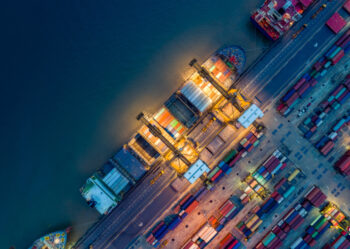Press Review SEA – January 2024

Red Sea: after numerous attacks on ships, freight rates soar
Due to intensified attacks by Houthi rebels in the Bab-el-Mandeb Strait, spot rates on the Asia-Mediterranean market rose by 70%. In addition, spot rates between Asia and Europe rose by 80% in one week. CMA CGM was the first carrier to react by announcing significant rate increases. The increases amount to $1,500 from Asia to Europe and the Mediterranean Sea. Geopolitical tensions are behind the rate hikes.
The Shanghai Containerized Freight Index (SCFI) reacted strongly to this situation. It has risen by 58.9% compared with the same week last year, and by 77% over the past five weeks. In response, carriers including CMA CGM and MSC have announced surcharges. These increases are intended to compensate for the extra costs involved in rounding the Cape of Good Hope, due to the increased risks in the Suez Canal region.
CMA CGM was the first to significantly increase its FAK (Freight All Kinds) rates, effective January 15. The increases range from $2,000 to $3,600, depending on destination. MSC followed with similar increases. Spot rates between Asia and the Mediterranean Sea reached record levels, increasing by 70% in one week.
Deteriorating geopolitical relations, notably the conflict between Hamas and Israel, are exacerbating the situation. Houthi attacks in the region exacerbate the situation. Shipping companies are reacting by diverting their ships via the Cape of Good Hope. This lengthens routes and leads to an increase in weekly rotations, boosting freight rates.
International naval operations raise tensions in the Red Sea to ensure ship safety. Maersk had planned to return via the Red Sea. After an attack on its vessel, the company suspended its transits in the region once again. Increased risks lead to higher marine insurance premiums. The southern Red Sea and the Bab-el-Mandeb Strait are designated high-risk areas.
BYD overtakes Tesla in the electric vehicle race
BYD, the Chinese manufacturer specializing in electric vehicles, surpassed its American rival, Tesla, for the first time in the fourth quarter of 2023. This was reflected in the delivery of more electric vehicles worldwide. This leading position should be maintained for some months to come. It is underpinned by the support of the Chinese authorities. The state is stimulating the local market and encouraging production in BYD’s factories.
In the last quarter of 2023, BYD delivered 526,409 electric vehicles. By contrast, Tesla came second with 484,507 deliveries. BYD, an acronym for “Build Your Dreams”, has become one of the most popular electric vehicle brands in China. The company has been focusing exclusively on hybrid and 100% electric models since 2022.
For the full year 2023, Tesla maintained its global leadership with 1.81 million vehicles delivered, marking a 38% year-on-year increase. Meanwhile, BYD recorded 1.57 million deliveries, an increase of 73% over the same period.
Competition between Tesla and BYD raises questions of unfair competition, as the Chinese manufacturer enjoys a significant structural advantage thanks to the Chinese government’s ongoing support for electric vehicles. This momentum is driving domestic demand, strengthening BYD’s position in the global market.
Although Tesla remains a major player in the electric vehicle market, it is facing increasing competition from China, which has over 100 electric car manufacturers on its territory. Despite this, Tesla CEO Elon Musk has announced his intention to increase the company’s production “as quickly as possible” to remain competitive.
China launches nuclear-powered cargo ship project
The text addresses concerns about China’s manufacturing dominance, encouraging companies to invest elsewhere to diversify away from industrial power. During the discussions in Beijing, criticism was voiced about the economic difficulties in the shipping sector. These result from the move towards a more diversified supply chain due to the preference for economies of scale. Established shipping companies, such as Cosco and Maersk, are experiencing financial difficulties. In addition, the Ningbo Composite Index is recording a significant year-on-year decline.
Against this backdrop, the text suggests reconsidering nuclear-powered vessels. It specifically mentions the concept of a 24,000-TEU CSSC nuclear-powered vessel, the KUN-24AP. Although details of this concept are limited, it appears to be equipped with a molten-salt nuclear reactor and all-electric propulsion. The concept highlights potential advantages, such as eliminating the need for engines and drive shafts. This would enable the use of more electric motors and azimuth gondolas. The text explores the possible operating profile of the vessel, emphasizing its design for high speeds. This contrasts with current trends towards slow sailing in container shipping.
The discussion raises concerns about the unproven technology of thorium molten-salt reactors. It also recognizes the expensive nature of nuclear-powered shipping. Despite the potential benefits, several challenges are identified, including the need for highly qualified nuclear engineering personnel and the potential reluctance of ports to accommodate nuclear-powered vessels. It is likely to be China that can make nuclear-powered ultra-large container ships a reality. This assertion is based on China’s industrial and maritime capabilities.
SEA has over 99% untapped wind and solar potential
The region has a solar potential of 30,523 GW and a projected wind power capacity of 1,383 GW. With only 27 gigawatts (GW) of solar power and 6.8 GW of wind power capacity installed by 2022, the member states of the Association of Southeast Asian Nations still have over 99% of potential wind and solar power capacity remaining untapped.
In a report, think tank Ember says the region has around 30,523 GW of solar potential and 1,383 GW of wind potential, citing estimates from the National Renewable Energy Laboratory.
“In order to attract investment, ASEAN countries need a favorable policy and regulatory environment, ensuring the implementation of attractive renewable energy pricing mechanisms and the rationalization of renewable energy supply chains,” the report reads.
“Investment in grid extension and modernization, combined with energy storage facilities, will be an essential prerequisite for the integration of solar and wind technologies into the power grid,” the report adds.
According to Ember, Thailand, Myanmar and Cambodia have the greatest solar potential, while Myanmar, Thailand and Vietnam could lead the region in potential wind power capacity.
For more information, please contact us at info@sneci.com





